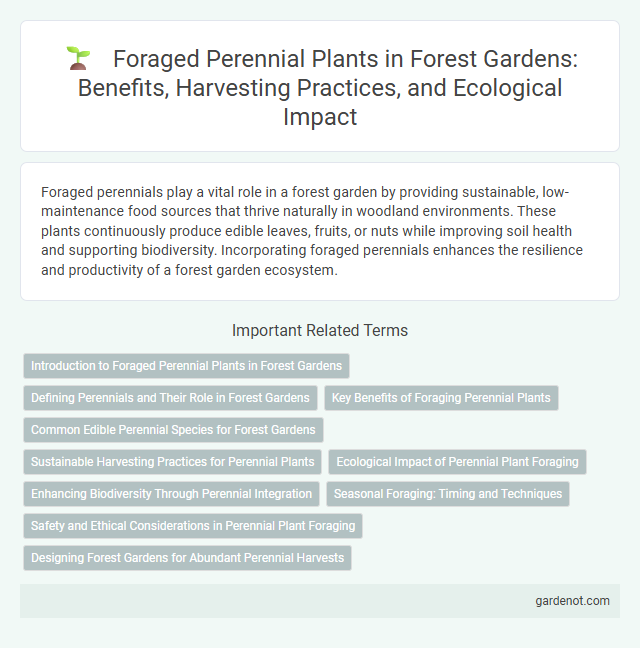Foraged perennials play a vital role in a forest garden by providing sustainable, low-maintenance food sources that thrive naturally in woodland environments. These plants continuously produce edible leaves, fruits, or nuts while improving soil health and supporting biodiversity. Incorporating foraged perennials enhances the resilience and productivity of a forest garden ecosystem.
Introduction to Foraged Perennial Plants in Forest Gardens
Foraged perennial plants in forest gardens offer sustainable, low-maintenance sources of food, medicine, and habitat that thrive through natural cycles. These plants, including wild berries, herbs, and roots, provide diverse ecological benefits such as soil regeneration and enhanced biodiversity. Integrating foraged perennials supports resilient agroecosystems by mimicking natural forest structures while yielding continuous harvests.
Defining Perennials and Their Role in Forest Gardens
Perennials are plants that live for multiple years, producing food and supporting ecosystems without the need for replanting. In forest gardens, foraged perennials play a crucial role by providing sustainable yields of fruits, nuts, herbs, and medicinal plants while improving soil health and biodiversity. Their deep root systems enhance nutrient cycling and resilience against environmental stress, making them essential components for long-term agroforestry success.
Key Benefits of Foraging Perennial Plants
Foraged perennial plants offer sustainable food sources that regenerate annually, reducing the need for replanting and minimizing soil disturbance. These plants provide diverse nutrients and support biodiversity by creating habitats for beneficial insects and wildlife. Their deep root systems enhance soil health by preventing erosion and improving water retention in forest garden ecosystems.
Common Edible Perennial Species for Forest Gardens
Common edible perennial species for forest gardens include elderberry (Sambucus nigra), which produces nutrient-rich berries ideal for jams and syrups, and Jerusalem artichoke (Helianthus tuberosus), known for its edible tubers that provide a reliable carbohydrate source. Hazelnut (Corylus avellana) offers valuable protein-rich nuts, while perennial herbs like chives (Allium schoenoprasum) contribute flavor and pest-repellent properties. Incorporating these foraged perennials enhances biodiversity, soil health, and year-round food availability in forest garden systems.
Sustainable Harvesting Practices for Perennial Plants
Sustainable harvesting practices for foraged perennial plants emphasize selective pruning and partial harvesting to maintain plant health and productivity. Techniques such as rotational harvesting prevent overexploitation and promote natural regeneration within the forest garden ecosystem. Incorporating native species adapts well to local conditions, ensuring long-term resilience and ecological balance.
Ecological Impact of Perennial Plant Foraging
Foraged perennials contribute significantly to biodiversity by providing stable habitats and food sources for pollinators and wildlife, enhancing ecosystem resilience. Their deep root systems improve soil structure, increase carbon sequestration, and reduce erosion compared to annual plants. Sustainable foraging practices of these plants support natural regeneration, maintaining ecological balance and promoting long-term forest garden health.
Enhancing Biodiversity Through Perennial Integration
Foraged perennials such as wild garlic, elderberry, and sea buckthorn significantly enhance biodiversity in forest gardens by providing diverse habitats and food sources for pollinators, birds, and soil microbes. Integrating these resilient species supports ecosystem stability and promotes nutrient cycling, contributing to a self-sustaining environment. Their deep root systems improve soil structure, reduce erosion, and foster beneficial microbial communities critical for long-term garden health.
Seasonal Foraging: Timing and Techniques
Seasonal foraging in forest gardens requires precise timing to harvest foraged perennials at their peak nutritional value and flavor. Key techniques include identifying the optimal growth stages of plants such as ramps, wild leeks, and sea kale, and using sustainable harvesting methods to preserve perennial root systems. Mastery of phenology and local climate patterns enhances yield and supports long-term ecosystem health.
Safety and Ethical Considerations in Perennial Plant Foraging
Foraged perennials in forest gardens require careful identification to avoid toxic species and ensure safe consumption. Ethical considerations include harvesting sustainably by taking only what is needed and preserving the plant population for future growth. Respecting local ecosystems and following legal guidelines helps maintain biodiversity and supports responsible foraging practices.
Designing Forest Gardens for Abundant Perennial Harvests
Designing forest gardens for abundant perennial harvests involves selecting diverse foraged perennials that thrive in layered plant systems, enhancing soil health, and maximizing space efficiency. Incorporating species such as wild berries, edible ferns, and medicinal herbs ensures a steady supply of nutritious, sustainable food sources year-round. Strategic plant placement supports natural pest control and improves biodiversity, creating resilient ecosystems that yield consistent perennial crops.
Foraged perennial Infographic

 gardenot.com
gardenot.com